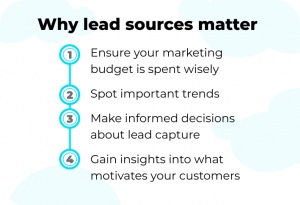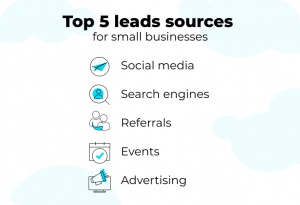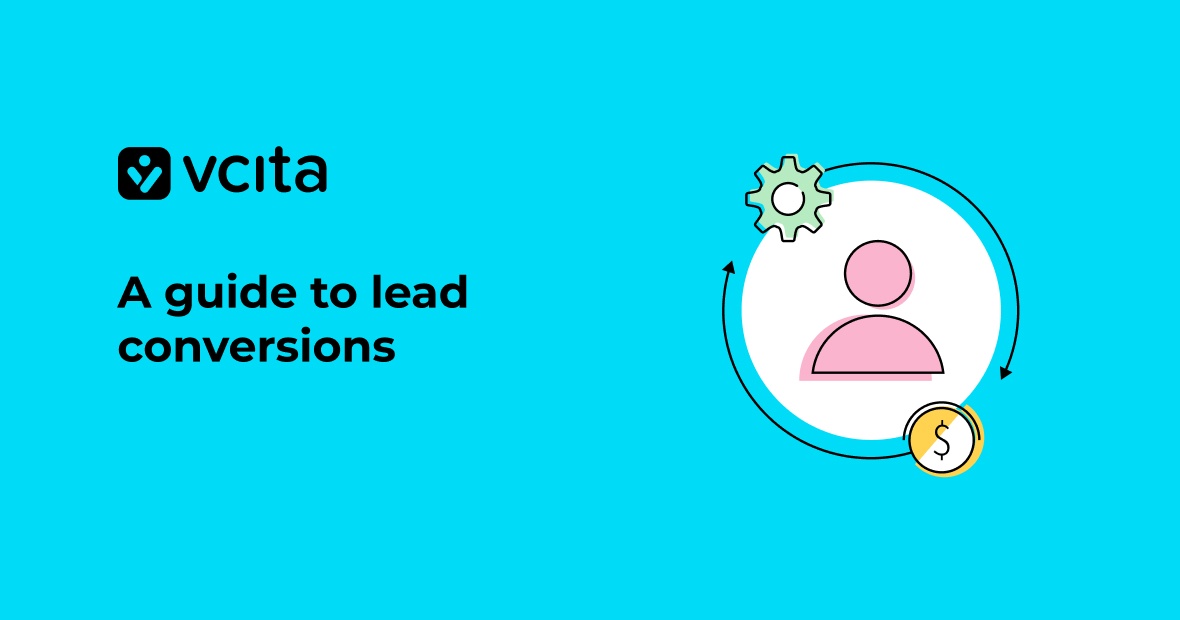As a small business owner, every lead matters. Every dollar spent on marketing and advertising matters. You don’t have huge budgets and massive teams to rely on. It’s up to you to make the most of your resources. The key is identifying your lead sources so you can double down on what’s effective and eliminate what’s not. When you know the sources generating your best leads, you’ll have the clarity and confidence to make decisions that move the needle. You’ll have insight into how to improve lead quality and increase lead volume to boost your sales pipeline.
In this article, we’ll get into what lead sources are, where to find them, and how to analyze and use the data they provide. If you’re not familiar with the world of lead sources, this article is for you.
What are lead sources and why do they matter?
As a small business owner, you need to know where your leads are coming from. Your lead sources are the channels through which potential customers first discover your business. Tracking them enables you to see what’s working and not working, so you can focus on successful marketing efforts.
Why lead sources matter
Lead sources are vital to growing your small business. When you know where your leads originate, you can determine which channels drive the highest quality leads at the lowest cost. This helps ensure your marketing budget is being spent wisely.
You can then optimize underperforming lead sources or reallocate funds to your top lead generators. Measuring lead volume and quality over time also allows you to spot important trends, like seasonal shifts or changes in customer preferences.
Armed with this data, you can make informed decisions to improve lead capture and conversion. For example, if most of your leads come from social media, focus on ramping up social campaigns. If website traffic is high but lead capture is low, improve your call-to-actions.

Tracking lead sources is how you gain valuable insight into what motivates your customers. Then you can refine your marketing to boost lead generation through the channels your customers frequent. In today’s competitive market, that kind of data-driven growth strategy is essential for small business success.
With dedicated lead source tracking, you’ll have the key metrics and marketing intelligence to expand your reach, attract high-quality leads, and ultimately, gain new customers. So make lead source analysis a priority, and watch as more and more people discover your small business.
The top 5 lead sources for small businesses
Discovering where your best leads come from allows you to concentrate on what’s working and make the most of your marketing budget. Here are the top 5 lead sources for small businesses:
1. Social media
Social media platforms like Facebook, Instagram, and LinkedIn are goldmines for leads. Build your following, engage with your audience, and promote your latest offers. People want to buy from brands they know and trust, so social media marketing should be a key part of your strategy. Facebook and Instagram provide excellent opportunities for connecting with your potential with data-based targeting algorithms, while on LinkedIn, the tool LinkedIn Ads Auction helps precisely target your ideal audience with the principle of auction, as the name represents.
Leveraging LinkedIn’s Sales Navigator can significantly enhance your lead generation efforts. This powerful tool allows for advanced search and filtering to pinpoint your ideal prospects. Moreover, with the ability to export LinkedIn Sales Navigator lists, you can seamlessly integrate these leads into your CRM or other marketing tools, ensuring a streamlined and efficient process for nurturing and converting these prospects into customers.
2. Search engines
If you show up on page one of Google for key search terms, you’ll drive tons of organic traffic and capture high-quality leads. Optimize your website for search engines through technical SEO, content creation, and backlinking. Pay-per-click advertising on search engines is also hugely effective for generating targeted leads.
3. Referrals
Don’t underestimate the power of word-of-mouth marketing. Satisfied customers are the best source for referrals. Focus on delivering amazing customer experiences and people will recommend you to their friends and family. Referral programs that offer incentives for referrals can help motivate your happy customers to spread the word.
4. Events
In-person events are perfect for networking, building brand awareness, and capturing new leads. Host your own local event or sponsor industry conferences and trade shows. Have a strong call-to-action to capture contact details from attendees. Follow up quickly while the experience is still fresh in their minds.
5. Advertising
Online advertising on social media and search engines allows you to reach new potential customers and drive leads. Build targeted campaigns based on your ideal customer profiles. A/B test different ads and landing pages to optimize your results. While advertising does require an investment, the ROI can be huge if done right.
Tracking and managing your leads properly is key to small business success. Know your numbers, focus on what’s working, and keep optimizing to grow your business. The opportunities are endless if you make the most of these vital lead sources.

How to capture lead source data
Use web forms to gather data
Add hidden fields to your website’s lead forms to capture information like:
- UTM parameters (to see which social network, blog, or ad led them to you)
- Referring URL (the page they were on before clicking to your site)
- Geographic location (city, state, country)
Store all this data in your CRM so you have a complete picture of each lead’s journey to becoming a customer.
UTM your links
UTM codes are those handy little tags you can add to links that tell Google Analytics where traffic is coming from. Use them on all your social posts, ads, email campaigns and track which channels drive the most leads. Then you can hone in on the channels that bring the most leads!
Find an integrative solution
Using a tool that captures lead data across websites, social, email, ads and more is ideal. Many integrate directly with a popular CRM like vcita so you have everything in one place. Look for a solution that tracks:
- Website activity (forms filled out, content viewed, etc.)
- Email opens and clicks
- Social media engagement
- Paid ad interactions
- And more!
With the right integrative solution tracking all your lead sources, you’ll have the insights you need to focus your time and money on growing your business. The more you know about your leads the bigger and better you can become.
Using lead sources to optimize your marketing
Knowing where your leads come from allows you to focus your marketing efforts on the strategies that are working. It’s an exciting process that provides insight into your target customers and how to best reach them. Here’s how to use the lead sources you tracked to better your marketing efforts:
See what’s working
By tracking lead sources, you can easily see which marketing channels are most effective at driving new leads. Maybe your social media campaigns are generating the most interest. Or perhaps your email newsletters have become a lead magnet. Use this information to double down on what’s working! Pour more resources into your top lead generators.
Optimize for your audience
Understanding where leads come from also helps you learn more about your target customers. If many leads come from a specific social network or search term, that signals the types of content and messaging that resonates most with your audience. Tailor future marketing around those insights to capture even more high-quality leads.
Evaluate and improve
Regularly reviewing your lead sources also allows you to make changes to underperforming marketing strategies. If a campaign isn’t producing results, try mixing up your content or switching to a different platform. Or, you may decide to stop spending time and money on tactics that aren’t working. Continually optimizing your marketing based on lead source data will maximize your results over time.
Tracking lead sources takes work, but the rewards of growth and optimization make it worth the effort. Dive into your analytics, see what’s working, and make a plan to take your small business marketing to the next level! Focus on the strategies resonating with your target customers and soon you’ll have a steady stream of new leads and sales.
Do more with the leads you capture
You owe it to yourself and your business to start tracking your lead sources today. Every small victory and conversion matters when you’re building something from the ground up. Know where your customers are coming from so you can focus on what’s working and make changes where needed.
The insights you gain will be invaluable for strategizing how to take your company to the next level. Don’t leave money on the table or miss an opportunity to connect with a new audience. Start keeping records now and watch as your business growth takes off. The effort will be well worth it when you’re able to look back and see how far you’ve come, all thanks to making the smart decision to track your lead sources from the very beginning. The sky’s the limit for your small business, so take the first step now!
FAQ: Lead sources and small business growth
Why You Need to Track Your Lead Sources?
As a small business owner, tracking how your leads first discover you is essential for growth. When you know where your customers come from, you can double down on what’s working and improve what’s not.
What exactly are “lead sources”?
Lead sources refer to the channels that initially expose people to your business. Some common examples include:
- Your website or blog
- Social media platforms like Facebook or Instagram
- Referrals from happy customers
- Online reviews and listings
- Live events like trade shows or networking
Why do lead sources matter so much?
Understanding your lead sources allows you to:
- Focus your marketing efforts on the channels that actually drive new leads
- Refine or replace underperforming lead-generation tactics
- Set measurable goals to scale your best lead sources
- Gain insight into your target customers and how they search for businesses like yours
How can I track my lead sources?
There are a few easy ways to monitor where your leads come from:
- Ask new leads directly how they first heard of your business and record their responses
- Use tools like Google Analytics to see referral traffic sources and measure lead conversion rates
What if I don’t track lead sources?
If you don’t track where your leads originate from, you’re missing out on valuable data to fuel your small business growth. Some potential downsides include:
- Wasting time and money on marketing that isn’t actually working
- Struggling to scale your customer acquisition efforts efficiently
- Making important business decisions based more on guesswork than facts
- Losing leads from your best sources due to lack of focus and optimization




























